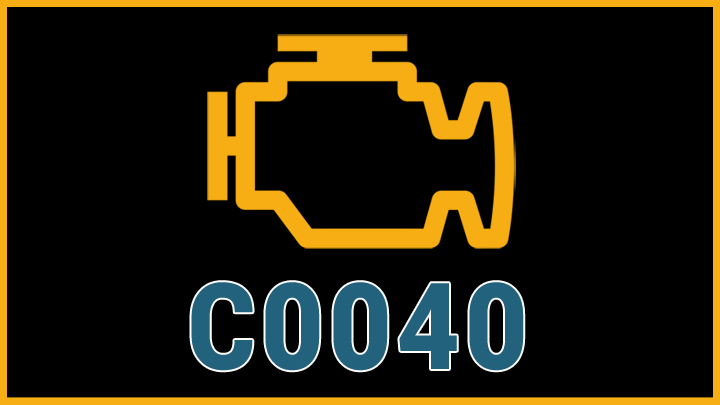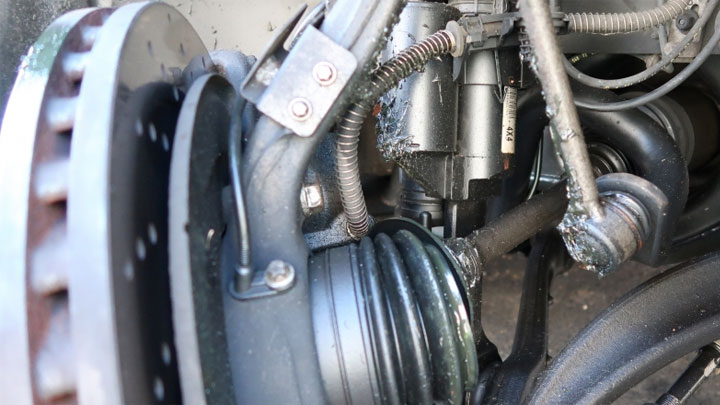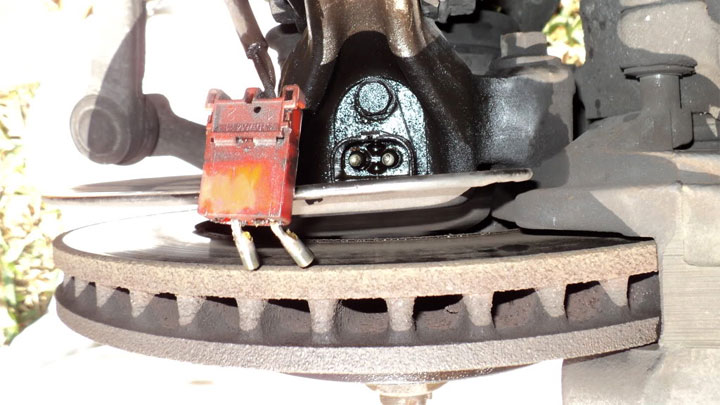C0040 Code (Symptoms, Causes, and How to Fix)
When your check engine light comes on and a C0040 code is the result (and maybe even an ABS light), it signifies a glitch with one of the wheel speed sensors that provides data to the ABS system.
This issue can be worrying, since driving without functioning ABS makes it harder to stop safely. Keep reading to learn what can cause a C0040 code, how serious it really is, and finally, how to fix it.

What Does Code C0040 Mean?
Diagnostic fault code C0040 is indicative of a faulty wheel speed sensor on the front right wheel (Code C0035 would be the front, left equivalent), or unspecified damage to its corresponding circuit.
Simply put, the vehicle’s ABS Sensor has determined feedback from the right-front speed sensor to be irrational, erratic, or non-existent, thereby signifying an out-of-specification condition.
Feedback is collected from each of a vehicle’s 4-wheel speed sensors, to substantiate the operation of several automotive safety systems, including anti-lock braking, and traction control. More specifically, this feedback is used as a means of identifying individual wheel lock-up or spin, thereby indicating an actionable condition within the confines of such safety systems.
To protect the integrity of automotive safety systems, such as ABS and traction control, the function of such systems is generally discontinued in light of a wheel speed sensor-related fault.
This ensures that these systems will not respond in error to inaccurate wheel speed data. Therefore, ABS and traction control function typically goes offline, when DTC C0040 is logged.
Symptoms of Code C0040
Diagnostic fault code C0040 is often accompanied by several different symptoms, some of which tend to be slightly more noticeable than others. Learning to recognize these signs can be key when attempting to expedite the diagnostic process as a whole.
Here are the most common symptoms associated with DTC C0040.
- Illuminated ABS light
- Possible traction control light
- Lack of ABS system function
Causes of Code C0040

Diagnostic fault code C0040 can be caused by one of several different underlying issues, virtually all of which relate to the affected wheel speed sensor circuit. Familiarity with these potential causes often proves game-changing when striving for a quick repair.
The following are several of the most common causes of DTC C0040.
- Faulty speed sensor
- Damaged wheel speed sensor reluctor wheel
- Wheel speed sensor circuit issues
- Compromised ABS module
Is Code C0040 Serious?
Generally speaking, diagnostic fault code C0040 is considered to be of moderate severity. While this fault code, when logged, will not prevent you from driving your vehicle, it does indicate an issue that requires further assessment and repair.
Therefore, you shouldn’t ignore your vehicle’s offending C0040 fault, simply because overall driveability does not suffer.
You should also bear in mind that an active ABS fault code of nearly any type will render the ABS system inoperable as a whole, DTC C0040 included. Therefore, a vehicle’s ABS function will not return until the underlying cause of DTC C0040 is diagnosed, and repaired.
Additionally, in a number of cases, additional safety systems utilizing wheel speed sensor feedback, such as traction control, will also be disabled.
In any event, the underlying cause should be promptly diagnosed and repaired to maintain safe vehicle operation. If you do not have the technical expertise to troubleshoot and fix this issue yourself, you should schedule service with a qualified automotive repair shop right away. Allowing electrical faults in critical steering components to persist often leads to more severe breakdowns.
How to Fix Code C0040

The following steps can be followed to assist in diagnosing and repairing the root cause of your vehicle’s C0040 diagnostic fault code. As always, consult factory-specific service literature for your particular model of vehicle before attempting any such repairs.
#1 – Scan For Additional Trouble Codes
Before beginning the diagnostic process, check for the presence of additional diagnostic fault codes with any decent OBD2 scan tool. Any such codes that are uncovered should be thoroughly diagnosed before proceeding.
#2 – Inspect Wheel Speed Sensor/Wiring
Begin the diagnostic process by carefully inspecting the affected wheel speed sensor, at its point of mount within the vehicle’s wheel hub. While it might not be possible to inspect the sensor in its entirety, you can verify that it is still secured within the hub, and free of obvious damage.
In addition, all related wheel speed sensor wiring should be inspected for signs of damage, binding, or fraying. Damage of any type would warrant replacement.
#3 – Inspect Hub Reluctor Wheel
Next, it will be necessary to inspect the vehicle’s right-front wheel hub for reluctor wheel damage. This, at the very least, will require the removal of the hub’s wheel speed sensor to gain a direct view of the reluctor wheel itself.
The front end of the vehicle can be elevated, allowing the front wheels to be spun by hand. In doing this, jack stands must always be used. Any evident reluctor wheel damage will necessitate hub replacement.
#4 – Check Wheel Bearing Play
While the front end of the affected vehicle is elevated, you should also check for excessive wheel bearing play at the right front wheel end.
This can be done by grasping the tire at this location in the 12 o’clock and 6 o’clock positions, before attempting to manipulate the tire in an inboard-to-outboard fashion. Any measurable play of this type will necessitate hub replacement
#5 – Check WSS Signal
If no issues have been found to this point, you’ll want to inspect all feedback from the right-front wheel speed sensor with the use of a quality scan tool. This feedback should be consistent, without any dead spots at speed, and should reflect increasing pulses as overall vehicle speed increases.
Anything to the contrary suggests the presence of a faulty speed sensor or associated wiring. If all measures are within manufacturer-supplied specifications, then further diagnosis of potential ABS module issues will be required.
All manufacturer-recommended procedures should be followed before condemning a vehicle’s ABS unit since that’s not a cheap replacement.
- P06dd Code (Symptoms, Causes, and How to Fix) - May 3, 2024
- 5 Symptoms of an EVAP Leak (and Repair Cost) - Apr 27, 2024
- P0480 Code (Symptoms, Causes, and How to Fix) - Apr 19, 2024
